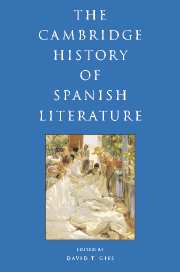Book contents
- Frontmatter
- I INTRODUCTION
- II HISTORY AND CANONICITY
- III THE MEDIEVAL PERIOD
- 2 Medieval Spanish literature in the twenty-first century
- 3 Beginnings
- 4 The poetry of medieval Spain
- 5 Medieval Spanish prose
- 6 The medieval theatre: between scriptura and theatrica
- IV EARLY MODERN SPAIN: RENAISSANCE AND BAROQUE
- V THE ENLIGHTENMENT AND NEOCLASSICISM
- VI THE FORGING OF A NATION: THE NINETEENTH CENTURY
- VII THE MODERN, MODERNISMO, AND THE TURN OF THE CENTURY
- VIII TWENTIETH-CENTURY SPAIN AND THE CIVIL WAR
- IX IN AND OUT OF FRANCO SPAIN
- X POST-FRANCO SPANISH LITERATURE AND FILM
- Bibliography
- Index
- References
5 - Medieval Spanish prose
from III - THE MEDIEVAL PERIOD
Published online by Cambridge University Press: 28 March 2008
- Frontmatter
- I INTRODUCTION
- II HISTORY AND CANONICITY
- III THE MEDIEVAL PERIOD
- 2 Medieval Spanish literature in the twenty-first century
- 3 Beginnings
- 4 The poetry of medieval Spain
- 5 Medieval Spanish prose
- 6 The medieval theatre: between scriptura and theatrica
- IV EARLY MODERN SPAIN: RENAISSANCE AND BAROQUE
- V THE ENLIGHTENMENT AND NEOCLASSICISM
- VI THE FORGING OF A NATION: THE NINETEENTH CENTURY
- VII THE MODERN, MODERNISMO, AND THE TURN OF THE CENTURY
- VIII TWENTIETH-CENTURY SPAIN AND THE CIVIL WAR
- IX IN AND OUT OF FRANCO SPAIN
- X POST-FRANCO SPANISH LITERATURE AND FILM
- Bibliography
- Index
- References
Summary
The foundations of the study of medieval literatures in the modern era were, of course, essentially philological. The preparation of a readable text from existing manuscripts (if more than one was available), the provenance of the manuscript(s) and the work(s) inscribed thereupon, and finally the ability to read and understand the medieval language(s) transmitted by these texts were the principal aims of an earlier generation of scholars and students. Some students of these works also understood that it was necessary to understand the modes of procedure of the scribal culture in which these literary artifacts originated. Later some scholars and critics began to apply a “new critical” approach in their analysis. Why were these pieces in and of themselves worthy of attention as literary objects?
New ways of viewing the so-called “literary text” began to emerge as the scholarly community came to appreciate and elaborate upon various approaches (linguistic, psychological, structural) which produced a notable effect upon the manner in which medieval works were read and interpreted. In recent years the “new historicists” have begun to question the validity of many of these approaches. Their views, which to some degree must have evolved from and along with those of the French historical writers concerned with “mentalités,” understand the medieval text as an artifact best analyzed in context, that is, in relation to the cultural codes which prevailed when the work was composed.
- Type
- Chapter
- Information
- The Cambridge History of Spanish Literature , pp. 95 - 114Publisher: Cambridge University PressPrint publication year: 2005



